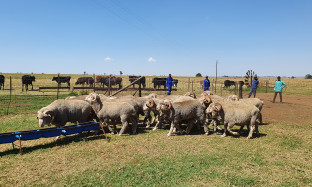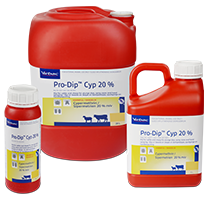
Karoo Paralysis Tick (Ixodes rubicundus)
There are 3 economically important paralysis-inducing tick species that occur in South Africa. They are the Red-legged tick (Rhipicephalus evertsi evertsi) , Brown paralysis tick (Rhipicephalus punctatus) and the Karoo paralysis tick (Ixodes rubicundus). Of the three species the Karoo paralysis tick is of the greatest importance.
The Karoo paralysis tick is a small red-brownish, shiny, eyeless tick and its legs are attached to the far front end of the tick.
Life Cycle:
The Karoo paralysis tick is a three host tick, which means every stage of the tick attaches to a different host. The larvae and nymph stages prefer Elephant shrews and Redrock rabbits. The adult stages prefer sheep, goats, antelope species and young calves.
The life cycle stretches over a 2 year period, which means a high tick density / challenge will not necessarily be followed by another high tick density / challenge the next year, as larvae and nymphs can occur during the first winter and adults during the next winter.
The female ticks lay about 2000 eggs over a period of 30 - 50 days. The eggs can take up to 8 months to hatch into larvae, the first active stage. The larval stage attaches to Elephant shrews, feed for 5 - 7 days before they drop off and the moulting process to the next stage (nymphal stage) takes place. This moulting period can take 18 - 20 days. The nymphal stage attaches to Redrock rabbits and they will feed for 6 - 8 days. Thereafter they will drop off the host and can over-summer as engorged nymphs to moult after the first cold spell during autumn into adult ticks. The adults will then quest for their preferred host - small stock. They will attach to these animals and feed for about 6 - 8 days, drop off and start with egg laying. Tick activity increases with cooler and wet weather.
Distribution
The Karoo paralysis tick prefers hilly areas, and is more often found on the south facing slopes where ”besembos” and “suurpol” grass occur. The adult tick use grass as questing sites at a height of approximately 45 cm, which correlates to the size of their host.
Attachment site:
The Karoo paralysis tick is found on the underside (belly) and the lower parts of the neck and legs, but seldom lower than the knees. Sometimes it will be found on the cheeks and jaw. About 20% of the ticks can be found on the backline (mostly in between the shoulder blades).
Disease transmission
The adult ticks that feed on livestock, excretes a toxin that causes ascending paralysis in sheep, goats and young calves. Paralysis starts in the hind legs and progresses to the respiratory system with fatal consequences. If the animals are found in the early phases of paralysis, the symptoms can be reversed by removal of the ticks.
Control
Dip animals strategically and frequently to reduce tick challenges. Amipor pour-on can be used.
Remove sheep from hillside camps during winter. However, if they are returned before the end of the winter, they should be either:
- Treated precautionary / preventatively or
- Monitored for tick challenge on animals within 3 days after entering the camp. Treat when necessary. A guideline when to treat is when ± 10 ticks are counted on large animals (> 50 kg) and ± 6 ticks on lighter animals (20 kg). Monitor the animals for at least 2 weeks.
Contact your local Virbac Technical sales advisor for more information regarding Karoo Paralysis tick and control measures for your farm.



